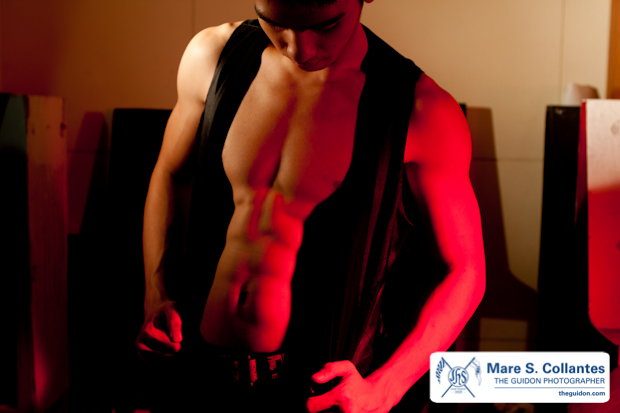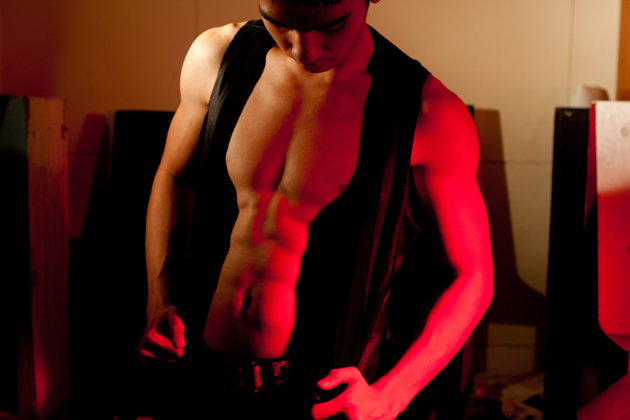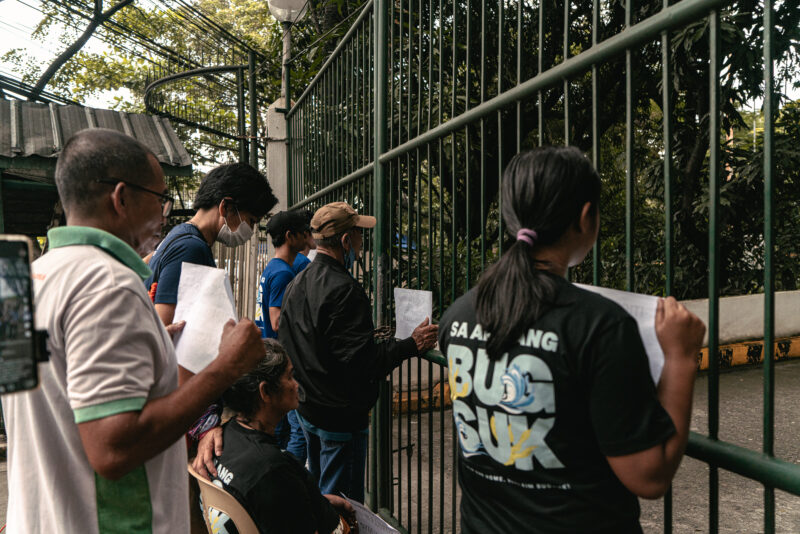
MAGIS MIKE. The world of stripping is far from the glamorized profession presented by Hollywood. Photo for illustrative purposes only. Photo By Mare S. Collantes
Bright lights dance on glistening skin as the bass pumps loudly into the night. A shapely young woman tugs at her knee-high boots, wearing little else. With a flirty smile, she snakes out of her lingerie, winking at the cheering crowd.
Films often depict the strip club scene as glamorous. The dancers themselves are presented as ironically deified objects of desire. In the movie Burlesque (2010), a small-town girl gets a sweet taste of fame while working as a burlesque dancer. The film Magic Mike (2012) shows women practically worshipping male strippers while they’re onstage. Many are introduced to the sultry side of nightlife through media, but the representations in it tend to miss the mark.
The truth lies in experiencing it. Under circumstances that are as strange as they are true, one Atenean discovered that for himself. He found out firsthand what other Ateneans have heard of through their strip club area immersions, and then some. After his eye-opening stint at a strip club, he reveals his story.
Setting the scene
Contrary to the one-size-glitz-all stereotype, strip clubs aren’t homogenous. They differ greatly based on their target clientele. Clubs that cater to foreigners tend to be better-lit, more upscale and more presentable than ones that cater to an all-Filipino crowd.
Tyler*, an undergraduate in the Ateneo, experienced this himself. He has always been interested in exhibitionism, and after experiencing an emotional breakdown earlier this school year, he decided to go after something he’s always wanted to do: stripping.
He auditioned at a small strip club near Tomas Morato. Applicants had to dance onstage in a tiny bikini and a piece of sheer cloth that left little to the imagination.
During the job interview, the recruiter asked where Tyler was studying. It was obvious how young Tyler appeared, as most of the workers were 21 to 27 years old. After he answered, the interviewer had a look of utter disbelief. Workers typically turned to this job in desperation. Though this was a gay bar, all of the models were straight. Some even had families. They simply had nowhere else to go.
The strip club workers that Ateneans meet during immersions in Olongapo are in a similar situation. They are stripping due to the difficulty of finding jobs, or because they were tricked into participating. “Some people are under the impression that [they] become bar girls because they want to,” Doms Gana (AB Psy ‘12) shares about the strippers in Olongapo. In truth, they often have no choice.
The workers in Olongapo are forced to allow their dignity to be compromised to a grave degree. The women are barely dressed at all, naked as livestock on display. Many possess a dazed, empty look in their eyes as they dance, due to their use of drugs. “Taking drugs was the only way that they would have the guts to do what they doto be used and objectified,” says Gana.
Cities away, the club Tyler found himself in housed sofas, a stage, a small ramp and a single pole for the models (the club’s term for dancers). Its appearance was decent enough, but backstage was another story.
The backstage area was a little over the size of a bar counter, but it held around 25 models who were waiting for their turn. The floor was littered with trash. The place itself didn’t have any clean water, and the performer’s bathroom was in horrible shape.
“It looks like a—sorry to say this, but—a squatter’s area,” Tyler notes. The space gave an air of being trapped. The dancers’ stifling surroundings, dirtied with the grime of the night, seemed as constricting as circumstance itself.
Darker waters
The darker side wasn’t limited to the strip club’s appearance. Though Tyler was recovering from a fever, he made it promptly to the 9:00 PM call time on his first day at work. Getting ready involved changing into revealing costumes in a communal backstage area. In this room, the models would later touch themselves to make their genitals look more prominent during their performances. Working here meant not being iffy about personal space.
A typical workday is from 9:00 PM to 4:30 AM. After countless hours of work, a model can earn P300 for every onstage dance, but due to the sheer number of models, most of them get to dance only once or twice per night. “Guest relations officers” (GROs) have a starting salary of P100. These fees exclude tips, but those are hard to come by.
That night, Tyler was a GRO. He was told to observe how the models dance. They moved very slowly, as if impressing each roll of the body unto the sound.
As he watched, one of the managers, Daddy Rob*, approached him. Managers were in charge of looking after the models, but Daddy Rob had his own way of doing things. He had a tendency to be sexually aggressive towards the models even if he was around 50 years old.
At one point, he put his hand on Tyler’s crotch, saying, “Gusto mo ng pera? Gusto mo ba akong chupain? (Do you want money? Do you want to give me a blowjob?)” Tyler tried to stay as far away as possible from Daddy Rob that night, but there weren’t any places to hide.
Meeting customers outside of work is grounds for termination for the models, but some are left with very few options. It becomes something else they have to conceal. “If the customer asks to meet up somewhere, you don’t tell any other person in the club,” Tyler recalls.
There are some models who suddenly get gifts from customers that are as luxurious as cars and condominium units. “I don’t know what they have to do,” says Tyler, “and I don’t want to think about what they have to do to get that.”
One of the models Tyler worked with had stopped stripping for three years because a customer was supporting him. The customer gave him a luxury car and a condominium in Makati, much to the oblivious delight of the model’s wife and child. He returned to stripping when the client stopped seeing him. It isn’t known if his family is aware of what he does for a living.
Dignity seems like a small price to pay for those in dire need of money. One model went onstage with just a sheer cloth covering his groin. He quickly discarded the cloth and danced completely bare. “[The models] themselves said it’s degrading. They hate doing that,” says Tyler. “But if it gets you tips, you’re going to do anything.”
Unexpected warmth
By 2:30 AM, Tyler’s fever was dangerously high. Seeing other models lying down on the cigarette butt-laden floor of the backstage area, he took to lying down on the dressing room table himself.
Several of the models checked up on him, one offering to talk to the managers to let Tyler go home early. Another offered to look for medicine, their warmth coming as a pleasant surprise.
“They had no idea who I was. I basically just dropped into their lives, and suddenly, they’re trying to take care of me like I was family,” Tyler shares.
One of the models, Leo*, extended this warmth to Tyler by showing him the ropes. Leo was a tall, winsome 27-year-old former soldier who had been working as a stripper since he was 21. A desperate need for money led him to try stripping. Leo was one of the few who finished studying, but other circumstances were not as kind. To this day, his family believes he’s working as a soldier.
He taught Tyler how to move, how to conduct himself in front of customers, and how to deal with people like Daddy Rob. He also warned Tyler about the job’s dangers. For example, one of the club’s customers asked a model out to dinner. When they met, the customer beat up the model instead.
There was a strong culture of camaraderie between the workers in the club. That their managers tell the models to refer to them as “mommy” or “daddy” goes beyond the mamasan connotation. They’re really there to take care of each other in an otherwise volatile environment.
Silent night
These experiences only reflect a fraction of what has been—and what continues to go—unheard. One obstacle faced by the men and women of the night is that few of their stories are ever told in full.
“Strippers suffer from social stigma… [That is] a cultural mechanism to regulate sexuality. Most think it best to hide [their work] to protect themselves from discrimination,” says Issa Mijares, a faculty member of the Sociology and Anthropology Department.
Tyler tried stripping out of his own volition, and he was able to walk away afterwards. However, this is rarely the case for those who do it for a living. It can be a potently hollowing experience. “It’s not something I’d actually want to do ever again on a regular basis,” Tyler admits.
Though there is the saving grace found in camaraderie and community, the dark complicates matters for those who can’t run away. From poor working conditions to physical and emotional harm, a lot lies obscured in the dark of Manila’s nightlife. The night keeps its secrets, asking not to be unmasked.
*Editors Note: Names have been changed to protect the interviewees.
- MAGIS MIKE. The world of stripping is far from the glamorized profession presented by Hollywood. Photo for illustrative purposes only. Photo By Mare S. Collantes














